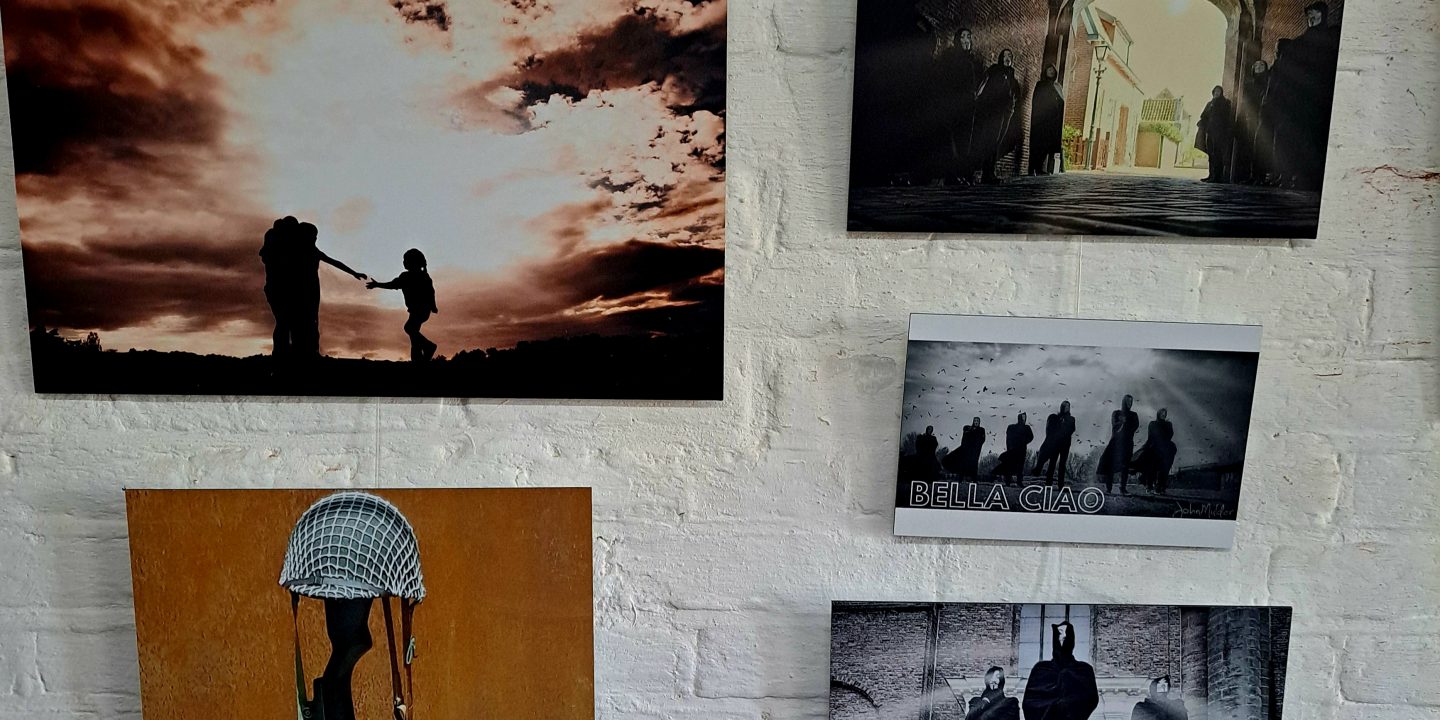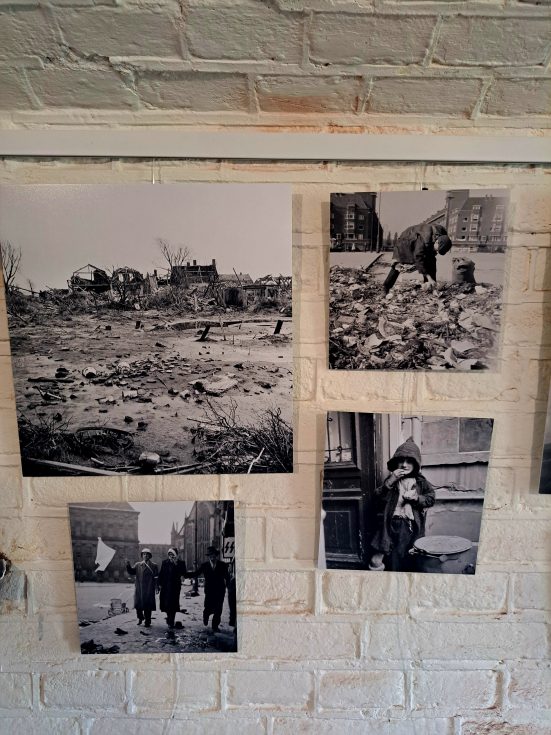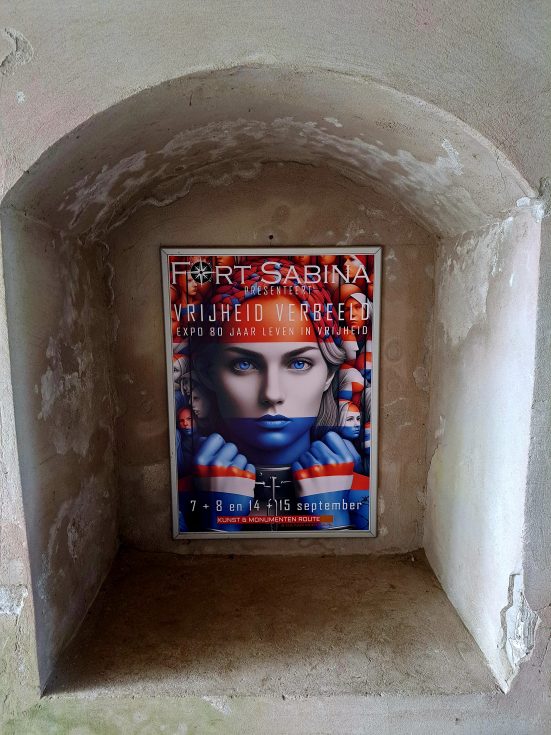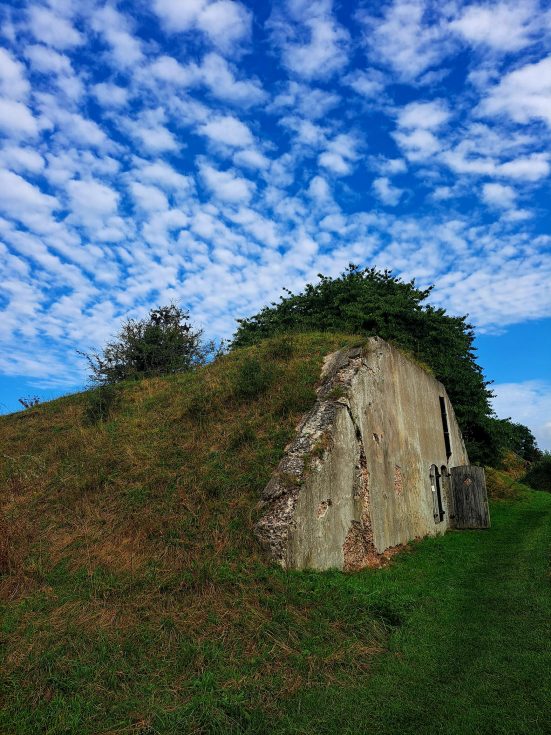
The sharp sound of the jets above Fort Sabina, where a commemoration of 80 years since Brabant’s liberation in WWII was taking place, not only pierced the sky but also seemed to tear through time itself; as if the sky itself held the echoes of something far deeper. They were a reminder that wars never really leave us. As I was exploring the fort, I couldn’t shake the feeling of unease, knowing that those jets were likely on their way to warzones; to a war that felt both distant and dangerously close. But life around me continued in strange normalcy—families were enjoying their weekend outing, enjoying their meals, children were playing and couples curiously wandering through the site. Yet, the present and the past seemed to collapsed into one that day, tangled together in a way that made me question everything I knew about the lines that separate war from peace, past from present.
This place, now a peaceful historical site, had once played its part in the brutal reality of World War II, an event that reshaped Europe and the entire world. The fort’s role in defense, much like so many others across the Netherlands, was part of the effort to protect freedom, to push back against occupation. It was hard to imagine that only eighty years ago, the skies over Europe were filled with planes, much like the ones I had just seen. Back then, they carried a weight of desperation, of fighting not just for borders but for the very essence of human dignity and survival. And this scene of jets heading ‘somewhere’ sent chills through my body, as it brought memories from the late nineties when I had seen those same skies filled with planes during the airstrikes on my homeland.
And here we are again, in 2024, with violence still shaping the lives of people.
The wars in the world aren’t some distant historical memory—they are ongoing, present, and real, not unlike the wars that scarred Europe a century ago. As I stood there within the thick walls of the fort, trying to shake off the shivers, my thoughts wandered to those places in which tragedies, the devastation and loss of life have been unfolding. Despite being thousands of kilometers apart, these events share the same threads of human suffering, violence, and the fight for survival, just as the wars of the past, like World War II once did.
As I walked through the Project ’44 photo exhibition, past the exhibits of uniforms, weapons and war photographs, I couldn’t help but reflect on how little has changed. The idea of defense, once limited to military might and fortified walls like those at Fort Sabina, now encompasses something much broader—the defense of human dignity, of rights, of the hope for a future without war. We build walls and fortifications to protect ourselves from threats, yet here we are, still entangled in the same struggles. Standing here, at a fort that once symbolized security, my mind drifted back to those fighter jets. I realized that freedom, safety, and peace are fragile things—constantly threatened, never guaranteed. Perhaps the real line of defense now lies not in walls or weapons, but in how we understand and confront the injustices that lead to war in the first place.
The contrast between the peacefulness surrounding Fort Sabina and the reality of war elsewhere brought up new questions. I thought of the people in war zones, and wondered: How, or will they even be able to remember it, decades from now? Will they, or their descendants, visit sites of past battles, seeing echoes of their own trauma reflected in the stories of wars long over? What do we really defend with our walls, our fortifications, our borders? And how far do we extend our empathy, our solidarity, to those whose freedoms are under attack? “Lines of defense”, what do they even mean? The lines that were once built with stone and mortar, designed to keep invaders out, now seem fragile, even obsolete. During World War II, the fight was clear-cut: good versus evil, democracy against fascism. But today, those lines feel blurred. War isn’t just about territory anymore; it’s about power, ideology, and survival, fought on battlefields but also in the hearts of people far from the front lines.
Today’s warfare is different—drones, cyberattacks, and airplanes redefine the concept of defense. Those planes flying overhead might be a sign of strength, advancement and power, but they also remind us of how vulnerable we are. A fort once symbolized safety; now, no such place exists. I wondered: do the people eating burgers and getting wedded around me feel this same unease? Do they sense the connection between the wars of the past and the present conflicts unfolding in the world? Some did, I found. Someone I spoke to explained that their parents had been held at Fort Sabina, and they often visit the sitein memory of them. Perhaps the exhibition on the theme of freedom—”Vrijheid”—was meant to remind us. Eighty years since the liberation and eighty-ish years since the end of the war, and we are still grappling with what freedom means, to the point where the photo competition which challenged artists to visually define freedom feels almost ironic. Can we ever truly define it, when war continues to threaten it for so many?
As I walked, I continued to question the idea of lines of defense. The notion of defense, both in the physical and philosophical sense, feels more complicated now. It’s not just about protecting borders but about safeguarding ideals—freedom, justice, and peace. These are the true lines of defense, and they are constantly under threat, not just by armies but by ideologies, greed, and the failure of diplomacy. Even here, in this peaceful corner of the Netherlands, we are not untouched. The panic I felt upon seeing those jets, guessing where they were headed, reminded me of the invisible connections that tie us to those far-off conflicts. Inequalities and humanitarian crises are part of the war’s reach, pulling us into its orbit even as we sit here, seemingly at peace, chatting away with strangers, colleagues, volunteer tour guides, sipping wine or capucchino, and doing research.
As I was reflecting on what Vrijheid/freedom means, I realised that freedom is not just a right we inherit but a condition that must be constantly defended. Their fight is not just about land; it’s about preserving their way of life, the identity, the culture, and the right to exist. It’s a fight that resonates with the stories of those who once battled for Europe’s freedom 80 years ago. As I was leaving the fort, the sound of the jets still echoed in my ears. The past and present had converged in a way I hadn’t expected, making me realise how fragile the peace we enjoy truly is. The places built in the past, like Fort Sabina, continue to shape our experiences and thoughts about conflict today. They remind us that while wars may end, the struggles for freedom and justice never truly do…





No Comments